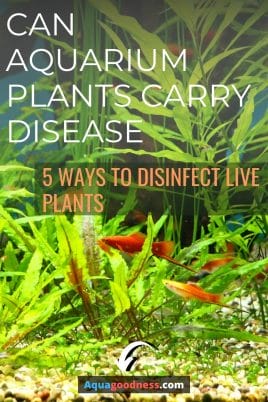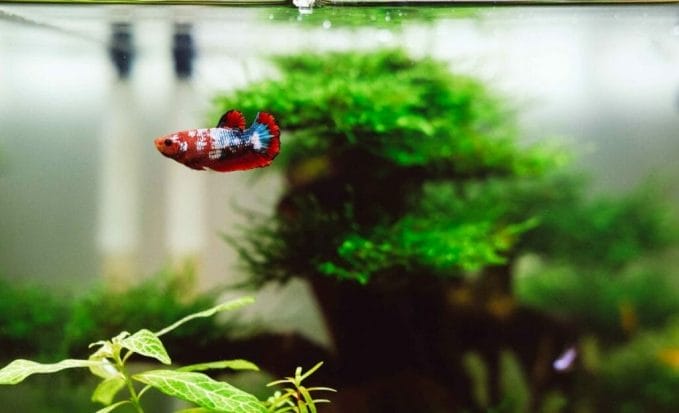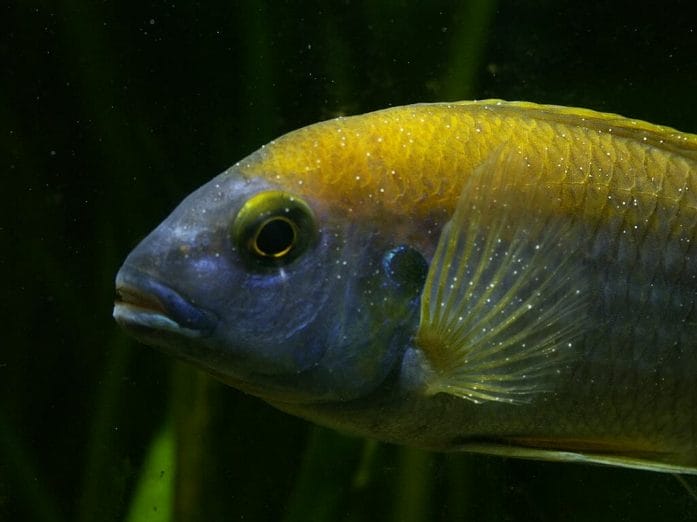Aquarium plants are great! There are a lot of benefits of keeping live aquarium plants in your tank such as they help to oxygenate the tank, filter the aquarium, etc.
However, if you don’t take precautions before adding the live aquarium plants in your tank then it can bring diseases in your aquarium.

Table of Contents
Can aquarium plants carry disease?
Aquarium plants can carry harmful diseases, algae, fungus, and bacteria in your aquarium.
It can also transfer potentially harmful organisms into your aquarium. That’s why it is always a good idea to disinfect the plants before adding them in your aquarium.
How to disinfect aquarium plants before planting them in your aquarium? (5 Ways)

There are several ways of disinfecting aquarium plants.
We will see all of them below.
But before getting into that, I just want to tell you there are some very sensitive plants that may not survive if you try to disinfect them using solutions which I am going to mention below.
So if you have any of those plants then the only solution for you to make it safe for your aquarium is to quarantine them.
1. Cleaning the plants using a potassium permanganate
This is a very common method of disinfecting live aquarium plants before planting them in your tank.
You just have to add potassium permanganate into the water until the color of the water changes to dark pink. And then you have to soak the live aquarium plants into the solution for about 10-15 minutes.
After 10-15 minutes pull out the plants and rinse the plants well in dechlorinated water.
2. Cleaning the plants using a bleach
To clean plants using bleach you’ll need to make a bleach solution.
To make the solution take one cup of bleach and mix it with 20 cups of water.
Now in this solution soak the plants for about two minutes.
After 2 minutes pull out the plants and soak the plants in dechlorinated water for about five minutes and then rinse it well with dechlorinated water.
Cleaning the plants with a bleach solution will remove any algae from the plant.
3. Cleaning the plants using aquarium salt
To clean plants using this method you have to make a solution of aquarium salt and water and then put the live plants into the solution for 10 to 15 seconds.
Just make sure not to dip the roots of the plants into the solution.
After 10 to 15 seconds pull out the plants and rinse them well with dechlorinated water.
If you don’t have aquarium salt then you can also use Kosher salt or rock salt.
Cleaning plants with aquarium salt will remove snails and snail eggs from the aquatic plants.
Are Aquarium Plants Hard To Keep?
4. Cleaning the plants using hydrogen peroxide
To clean the plants using hydrogen peroxide you will have to make a hydrogen peroxide solution of 2-3 ml of hydrogen peroxide and one gallon of water.
Once you made the solution then put the plants into the solution for 10 to 15 seconds.
Just make sure not to dip the roots of the plants into the solution.
After 10 to 15 seconds pull out the plants and rinse them well with dechlorinated water.
A quick note on cleaning the plants using a hydrogen peroxide solution- You should never clean merino mass ball using hydrogen peroxide solution because it can kill them.
Also, you should avoid cleaning any other sensitive plants using hydrogen peroxide solution.
Use hydrogen peroxide solution only to clean hardy aquarium plants.
5. Quarantine the live aquarium plants if you can
If you want to be on the safest side and you can’t risk transferring any harmful disease in your aquarium then you should quarantine the live aquarium plants for three weeks after disinfecting the plants using the methods mentioned above.
During the quarantine period, the disease-causing organisms will die because they will not get any host to survive.
3 Ways to keep live aquarium plants alive before planting
Other precautions to take to maintain a healthy ecosystem and fish health in your aquarium

Besides disinfecting the live aquarium plants, there are some other things you should keep in mind to avoid complications due to aquarium plants
1. Do not add a lot of plants at once
Adding plants in the aquarium is beneficial for the ecosystem of your tank.
But adding the live aquarium plants in the tank changes the water chemistry.
This change does not affect the ecosystem of your aquarium negatively.
However, when you add a lot of plants at the same time in your tank, it changes the water chemistry of your aquarium drastically which can affect the fish.
That’s why to be on the safer side you should not add a lot of plants at the same time in your aquarium.
You should add a few plants and let the water chemistry change and let fish get used to the change.
And after a few days or weeks, you can add more plants in your tank.
Are Aquarium Plant Fertilizers Safe For Fish?
2. Watch out for white fungus
Once you have taken all the precautions before planting the live aquarium plants in your tank still you should watch out for any fungus growing on your live aquarium plants.
Specifically, look for white fungus because it can be very harmful to the fish in your aquarium.
The fungus can also grow on the gravel and decorations in your aquarium.
So if you noticed white fungus then you should immediately remove the live plants or the affected decorations from your aquarium and clean them with a hydrogen peroxide solution.
20 Tips to Maintain a Healthy Aquarium
How to know your fish is sick or not and how to treat your fish in case your fish is sick?
Now we will discuss a common disease that can cause to your fish due to the addition of infected plants in the aquarium.
I’ll tell you the symptoms and treatment of the disease.
Ich

Ich is the most common disease in the aquarium.
Usually, any new addition that could be a new fish or live aquarium plant causes Ich. And as Ich is very contagious, it rapidly infects all the fish in your tank.
Besides, a sudden drop in the temperature of your aquarium water can also cause Ich to the fish in your aquarium.
The binomial name of Ich is Ichthyophthirius multifiliis.
It literally means “the fish louse with mini children”.
Ich is also commonly known as white spot disease because if the fish is infected with the disease you will notice white crystal-like spots at the earlier stage on the fin and then throughout the body.
These white spots can grow as large as 1 mm in diameter.
It is a direct parasite which basically means that it doesn’t need any host to spread the disease.
Ich can affect most of the freshwater fish.
However, some fish are more susceptible to the disease such as rainbow trout, catfish, and eels.
And other fish such as Minnows, Zebrafish have innate protection against Ich. And even if they get Ich they will recover faster than other species of fish.
There are two types of ich-
1. Ich that comes from external sources like any new addition such as new fish or new live aquarium plant is the harmful one.
2. And the other type of ich is commonly known as stress ich which is not very harmful.
Now the way to differentiate between these two types of ich is if you noticed a few spots today on the fin of your fish and it didn’t replicate too much the next day then it is stress ich. And in this case, you don’t need to do any medication. This ich will go away automatically.
On the other hand, if you noticed a few spots on the fins of your fish today. And tomorrow if you noticed a lot of spots on the fish then it has come from the external source. And in this case, you’ll need to treat the ich with the medication mentioned below.
Are Plastic Aquarium Plants Safe?
How to treat Ich?
The easiest way to treat ich is by using an aquarium safe each medication such as aquarium solutions ich x. Check the reviews and price of the medication at Amazon here.
Before treating your fish with the medication, just make sure that the temperature of the water in your aquarium is between the ideal temperature range of the fish in your aquarium.
Now add the Aquarium solutions ich x in your aquarium according to the instructions mentioned on the packaging which is 5 ml for 10 gallons of water.
After adding the medication wait for about 24 hours and then do a water change of about 20% to 30%. And again add the medication as recommended on the packaging of the medication.
Now you will have to repeat this process until you don’t see any white spots on your fish.
If after five days you can still see the white spots then probably it is not the ich you are dealing with. And you may have to re-evaluate the diagnosis.
Do Goldfish Like Plants in the Tank? (5 Best Plants for Goldfish)
FAQ
You can catch diseases from fish tanks however it is very rare.
If you just follow some simple healthy practices like washing your hands with soap after feeding your fish and cleaning your aquarium or doing any aquarium maintenance work, not letting children’s less than 5 years of age to touch the aquarium water, etc then you don’t need to worry about causing any disease due to fish tank.
Do Aquarium Plants Need a Heater?
If you add too many plants in your tank then it can kill your fish.
The reason behind this is plants are living organisms and they respire. When there are lights on they take carbon dioxide and release oxygen.
But at night time when The lights Are off this process reverses and plants take Oxygen and release carbon dioxide.
So, if you add a lot of live aquarium plants in your tank then as the plants release carbon dioxide during the night and take oxygen it can cause oxygen deficiency in your aquarium which will suffocate the fish in your tank and ultimately lead to the death.
Besides, not only at the night but oxygen deficiency can also occur during the day if you add too many plants in your tank.
This is because plants respire in the daytime as well. So during the day they also take in oxygen and this can cause oxygen deficiency in the tank which can lead to the death of the fish in your aquarium.
Now the solution to this problem is, first of all, you should not add too many plants in your aquarium.
And secondly, you should run an air pump in your aquarium during the night time.
The air pump will agitate the surface of the water of your tank which will help to keep your tank well oxygenated during the night.
Do Aquarium Plants Need Light? (Do they really need a special light)
Hydrogen peroxide can kill the beneficial bacteria in your aquarium.
However, it will take a very large dose of hydrogen peroxide to kill the beneficial bacteria in your tank.
If you want to use hydrogen peroxide solution to remove algae and snails from the plants and ornaments in your tank then what you can do is remove the plants and ornaments and spray hydrogen peroxide solution on them using a spray bottle.
Now you should replace the plants in your tank and do a water change of 20% to 30% of the water in your tank.
Do Aquarium Plants Need CO2? (Can you keep them without co2)
There are a lot of benefits of keeping live aquarium plants in a fish tank such as live aquarium plants help to oxygenate the tank, they help to emulate the natural habitat of the fish, etc.
However, you do have to take some precautions before planting the live aquarium plant in your tank. And you will also have to do the regular maintenance of the plants which can take some time.
So overall, it is just a personal preference if you want the live plants in your tank or not.
Do I Need to Fertilize My Aquarium Plants? (Is it really necessary?)
Conclusion
Overall, aquarium plants can carry harmful diseases, bacteria, fungus, and unwanted organisms in your tank.
That’s why you should always disinfect the live aquarium plants and quarantine them if you can for three weeks before planting them in your tank.
I hope you found this article helpful.
If you do, please share it.
Happy fishkeeping!
Related Articles:
- Do Aquarium Plants Absorb Ammonia? (5 best plants to reduce ammonia in a fish tank)
- Do Aquarium Plants Reduce Algae? (5 Best plants to reduce algae)
- Do Aquarium Plants Need Substrate? (5 Easy aquarium plants that don’t need substrate)
- Do Aquarium Plants Need Air Pump? (Is it really necessary?)
- 29 Best Tropical Aquarium Plants (And care guide for beginners)